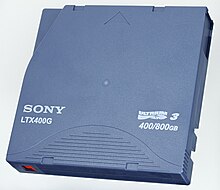
Back Linear Tape Open Czech Linear Tape Open German Linear Tape-Open Spanish Linear Tape-Open Estonian اولتریوم Persian Linear Tape-Open Finnish Linear Tape-Open French Linear Tape-Open ID Linear Tape-Open Japanese 리니어 테이프-오픈 Korean
 | |
 A 400 GB LTO-3 cassette by Sony | |
| Media type | Magnetic tape |
|---|---|
| Capacity | Up to 18 TB |
| Developed by | LTO Consortium (Hewlett Packard Enterprise, IBM, Quantum) |
| Manufactured by | Fujifilm, Sony (tapes) IBM (drives) |
| Dimensions | 102.0 × 105.4 × 21.5 mm (4.0 in. x 4.1 in. x 0.8 in.) |
| Usage | Archival storage |
| Released | 2000 |
Linear Tape-Open (LTO), also known as the LTO Ultrium format,[1] is a magnetic tape data storage technology used for backup, data archiving, and data transfer. It was originally developed in the late 1990s as an open standards alternative to the proprietary magnetic tape formats available at the time. Upon introduction, LTO rapidly defined the super tape market segment and has consistently been the best-selling super tape format.[2][3] The latest generation as of 2021, LTO-9, can hold 18 TB in one cartridge.
Cartridges contain hundreds of meters of half-inch (12.65 mm) wide tape media wound onto a single reel. Mechanisms (a.k.a. tape drives, streamers) extract the tape from the cartridge and spool it up on a second reel in the mechanism, reading or writing data as the tape moves between reels. Robotic libraries exist that can hold hundreds or thousands of LTO cartridges and dozens of mechanisms.
The original version of LTO Ultrium, called LTO-1, was released in 2000 and stored 100 GB of data in a cartridge; throughout newer generations, the capacity has increased while maintaining the same physical size. They feature built-in encryption for safer storing and transporting of data, and the partition feature enables usage of LTFS, generally having higher capacity, better long-term stability, and lower unit cost than other data storage formats. There are also write once read many LTO cartridges, useful to protect against accidental or malicious deletion.
- ^ "What is LTO tape technology?". Ultrium LTO. Hewlett Packard Enterprise Company, International Business Machines Corporation and Quantum Corporation. Archived from the original on 2024-08-20. Retrieved 2023-12-13.
- ^ Cite error: The named reference
freemanreports-1was invoked but never defined (see the help page). - ^ Cite error: The named reference
freemanreports-2was invoked but never defined (see the help page).